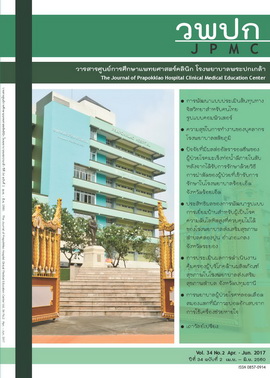การพัฒนาแบบประเมินต้นทุนทางจิตวิทยาสำหรับคนไทย รูปแบบคอมพิวเตอร์
Main Article Content
Abstract
บทคัดย่อ
ที่มาของปัญหา: จากความก้าวหน้าของเทคโนโลยี จึงมีการนำคอมพิวเตอร์มาใช้อย่างแพร่หลายใน ปัจจุบัน การประเมินต้นทุนทางจิตวิทยารูปแบบเก่าเป็นแบบเขียนตอบ (paper pencil) การนำเทคโนโลยีคอมพิวเตอร์มาใช้ในการประเมินต้นทุน ทางจิตวิทยาจะช่วยให้การประเมินต้นทุนทาง จิตวิทยามีความสะดวกในการใช้งานมากขึ้น
วัตถุประสงค์: เพื่อพัฒนาแบบประเมินต้นทุนทาง จิตวิทยาสำหรับคนไทยรูปแบบคอมพิวเตอร์โดย ศึกษาค่าความเชื่อมั่นเชิงความสอดคล้องภายใน ค่าสัมประสิทธิ์สหสัมพันธ์และระดับความพึงพอใจ ในการใช้แบบประเมินต้นทุนทางจิตวิทยาสำหรับ คนไทยรูปแบบคอมพิวเตอร์
วัสดุและวิธีการ: การศึกษานำร่องโดยกลุ่มตัวอย่าง ที่ใช้คือ นักเรียนชั้นมัธยมศึกษาปีที่ 4-6 ใช้วิธีการ สุ่มตัวอย่างแบบกลุ่ม (cluster random sampling) เครื่องมือที่ใช้ในการวิจัยคือ แบบประเมินต้นทุน ทางจิตวิทยารูปแบบคอมพิวเตอร์และรูปแบบ เขียนตอบ (paper pencil) และแบบสอบถามความ พึงพอใจในการใช้งานแบบประเมินต้นทุนทาง จิตวิทยารูปแบบคอมพิวเตอร์วิเคราะห์ข้อมูลด้วยกระบวนการทางสถิติ โดยการแจกแจงความถี่ ค่าร้อยละ ค่าเฉลี่ย ส่วนเบี่ยงเบนมาตรฐาน และ ค่าสัมประสิทธิ์สหสัมพันธ์แบบเพียร์สัน
ผลการศึกษา: แบบประเมินต้นทุนทางจิตวิทยา รูปแบบคอมพิวเตอร์ มีค่าความสอดคล้องภายใน รวมทั้งฉบับเท่ากับ 0.952 ในขณะเดียวกัน ค่าสัมประสิทธิ์สหสัมพันธ์ของแบบประเมินต้นทุน ทางจิตวิทยาสำหรับคนไทย รูปแบบคอมพิวเตอร์ มีความสัมพันธ์เชิงบวกในระดับสูง (r = 0.986) กับแบบประเมินต้นทุนทางจิตวิทยาสำหรับ คนไทยรูปแบบเขียนตอบ (paper pencil) ในส่วน ของความพึงพอใจต่อการใช้งานแบบประเมิน ต้นทุนทางจิตวิทยาสำหรับคนไทยรูปแบบ คอมพิวเตอร์พบว่ากลุ่มตัวอย่างมีความพึงพอใจ อยู่ในระดับพึงพอใจมาก
สรุป: แบบประเมินต้นทุนทางจิตวิทยาสำหรับคน ไทย รูปแบบคอมพิวเตอร์มีประสิทธิภาพเพียง พอที่จะเป็นทางเลือกหนึ่งของเครื่องมือในการ ประเมินต้นทุนทางจิตวิทยาสำหรับคนไทยต่อไป
The Development of Thai-Psychological Capital Inventory Computerized Version
Abstract
Background: Since the technology has been advanced dramatically, computers play an important role and have been used widely nowadays. The traditional Thai-psychological capital inventory is the paper pencil version. The introduction of computer technology to assess psychological capital will be faster and more convenient.
Objective: To develop the computerized version of Thai-psychological capital inventory by studying the internal consistency, correlational validity and the satisfaction of the users with the computerized version of Thai-psychological capital inventory.
Material and Methods: This research was a pilot study. The sample was chosen by using cluster random sampling from students (grade 9-12). The research materials were a computerized version and the paper-pencil version of Thai-psychological capital inventory, and the satisfaction questionnaire after using the computerized version of Thai-Psychological capital inventory. The data were statistically analyzed by using frequency, percentage, mean, standard deviation and Pearson's correlation coefficient.
Results: The computerized version of Thai-psychological capital inventory had internal consistency and reliability of 0.952, while the computerized version of Thai-psychological capital inventory had a high positive correlation (r = 0.986), compared with the traditional version. The level of satisfaction in using the computerized version of Thai-psychological capital inventory showed that satisfaction levels were very satisfied.
Conclusions: The Thai-psychological capital inventory computerized version was effective and powerful enough to be an alternative tool instead of the traditional version in order to assess the psychological capital for Thais.
